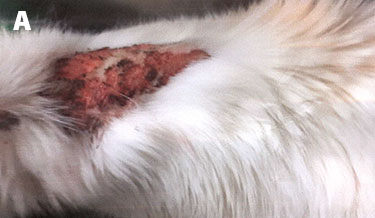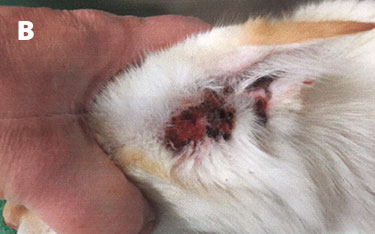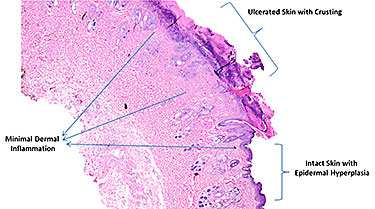Feline idiopathic ulcerative dermatitis: What do we know to date?
By Dr. Chanran Ganta

|
||

|
||
| Figure 1: Feline Idiopathic Ulcerative Dermatitis in a 15-year-old male neutered cat. There is a deep ulcer on the caudal dorsal neck are (A) and behind the ears bilaterally (B) | ||

|
||
| Figure 2: Marked ulceration with crusting with acute transition to intact skin showing epidermal hyperplasia with very minimal dermal inflammation |
Disease condition
Feline idiopathic ulcerative dermatitis is a rare skin disease seen exclusively in cats with a classic presentation characterized by large non-healing ulcerations on the dorsal midline of the caudal neck and beyond the ears (See figure 1). On clinical presentation, these lesions are usually solitary, starting as a focal area of alopecia progressing to erythema and ulceration. The presence of pain and pruritis is variable, but can be seen as the cat intermittently and maniacally self-traumatizes the lesion. Only regional lymphadenopathy will be noticed with no systemic signs. There is no age, breed or gender specificity associated with this condition.
Etiology
As “idiopathic” suggests in the name, feline idiopathic ulcerative dermatitis has no known etiology. Previous reports suggest it occurs secondary to injection-site reactions but there are several cases reported where similar lesions have developed with no history of injections. It is speculated that the location where lesions occur undergoes hyperstimulation of nerve endings (neuropathic itch syndrome).
Diagnosis
Differential diagnoses include physical or chemical injury, injection-site reactions, foreign bodies, fungal, bacterial and viral infections, Demodex gatoi infestation, hypersensitivity disorders and neoplasia.
The clinical presentation of lesions is very unique with large focal ulcerative lesions on the dorsal midline of the distal neck or between the scapula and in some cases extend beyond the ears. A biopsy taken from the margin of the lesion including ulcerated and non-ulcerated areas will be helpful in a definitive diagnosis. Histologically, the epidermis is markedly ulcerated with necrosis that extends to the superficial dermis. The intact epidermis along the margins of the lesion show epidermal hyperplasia with little to no dermal inflammation (Figure 2). In chronic cases ranging from 6 months to 1 year, there will be classic subepidermal linear fibrosis observed.
Management
The prognosis is guarded to poor because lesions are often refractory to medical treatment and may be too extensive for surgical resection. To date there have been two published reports available on the treatment of this condition. I recommend reading the following articles:
- Topiramate in the management of feline idiopathic ulcerative dermatitis in a two-year-old cat David Grant and Clare Rusbridge. Vet Dermatol 2014; 25: 226.
- Feline idiopathic ulcerative dermatosis treated successfully with Oclacitinib. Conference Paper · April 2015 North American Veterinary Dermatology 2015, At Nashville, TN, USA.
Acknowledgements
We thank Dr. Vickie Smith, Smith Veterinary Clinic, Tonganoxie, KS, for submitting this case to KSVDL and allowing us to publish the gross images.